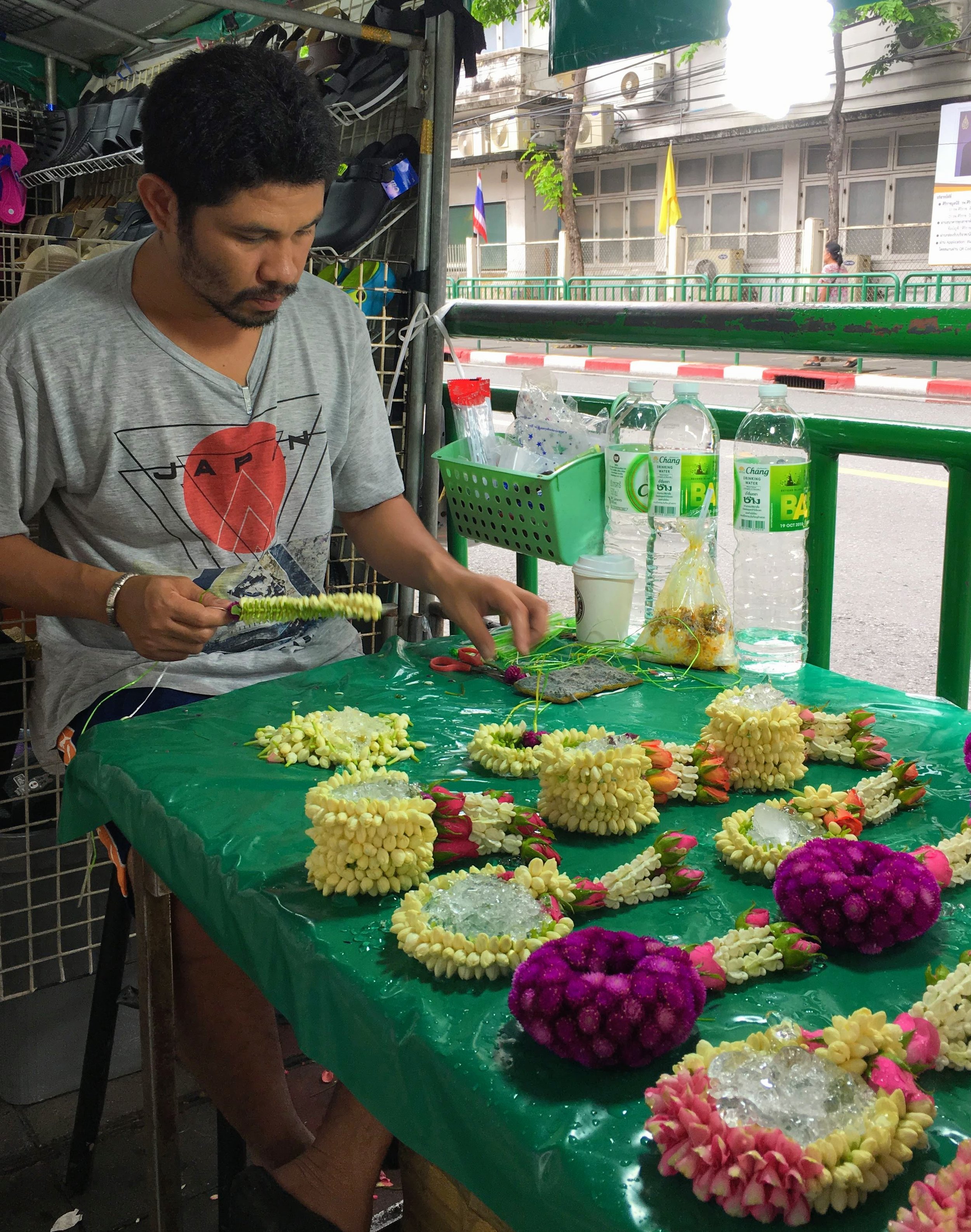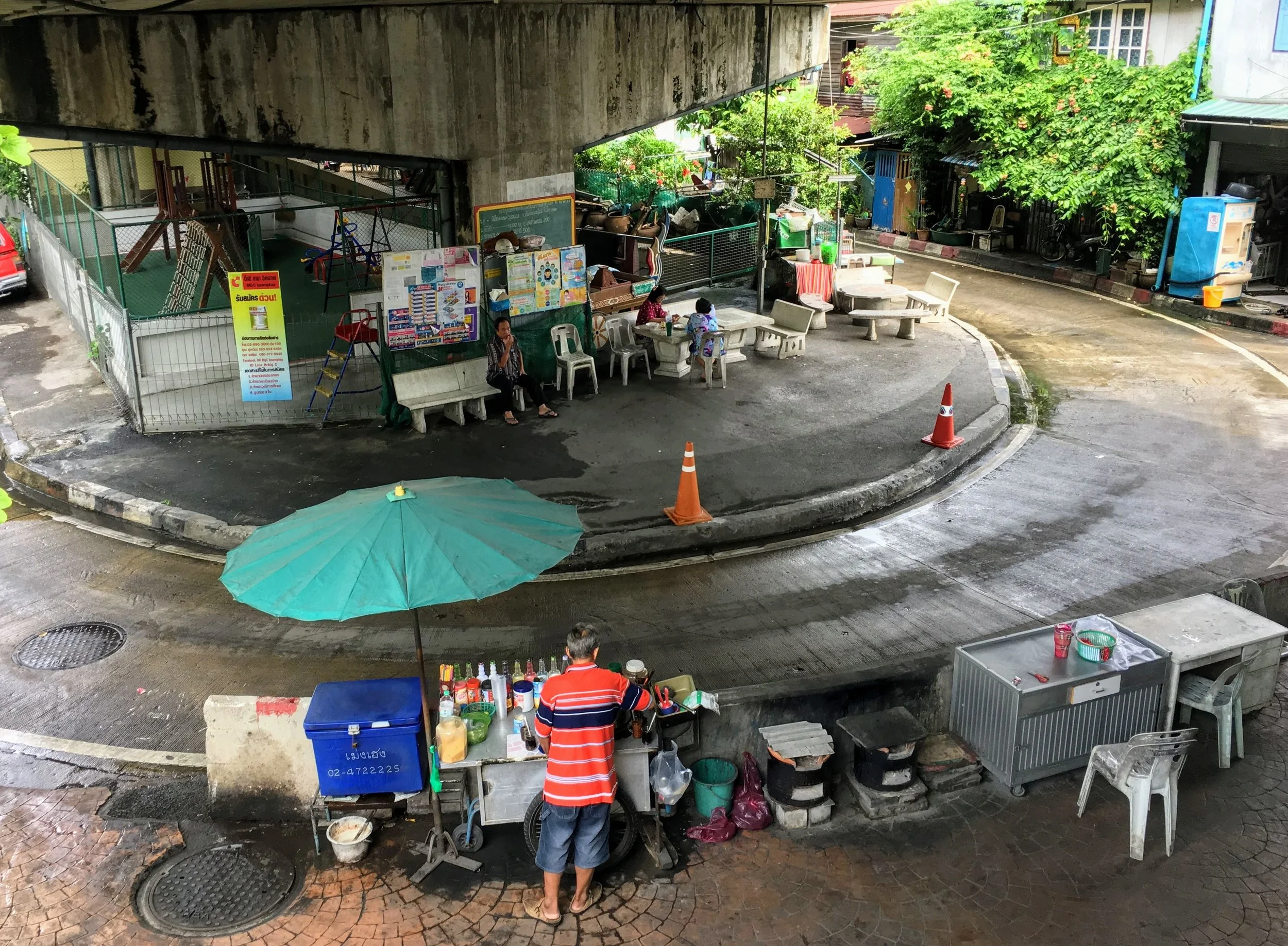Bangkok Quickie
The final stop on our border run for renewing our Thai visa was a short stay back “home” in Thailand—two quick days in Bangkok. The city’s ceremonial name is Krungthepmahanakhon Amonrattanakosin Mahintharayutthaya Mahadilokphop Noppharatratchathaniburirom Udomratchaniwetmahasathan Amonphimanawatansathit Sakkathattiyawitsanukamprasit so who wouldn’t want to revisit the Guinness Record of the world’s longest place name!
Sometimes when I visit a city I don’t want to be a tourist. I just want to hang out for the day in our AirBnB, read a bit, walk around the neighborhood, maybe find a coffee house, or make friends with a nearby shopkeeper.
Ace travel agent George, who is always looking for the “great” deal, found us a converted tool shed in someone’s back yard, overlooking a canal in a very Thai residential neighborhood. He never disappoints! By the way, AirBnB is illegal here, but it still operates. Hosts often add to their descriptions: '“Do not talk to the neighbors; if they ask, you’re my relative—do not worry, you will not be arrested.” Makes one think twice before hitting send payment.
Well, the tool shed was great. It was nicely renovated into a studio with western-style bathroom and a cute loft, facing a klong (canal) on the Thonburi west bank of Chao Phraya River (not far from Wat Arun). Our hostess and her mother live on the same property in a very large house built by her grandfather, so we did not have to worry about inquiring neighbors. And as George said it was a real neighborhood filled with the local ambiance of a vibrant multi-religious community, away from tourists, touts, and tuk-tuks. Upon arrival by taxi that night at the alleyway (yes, George’s “great deal” was again down a long alleyway), the hostess met us, and we walked about 100 yards to her property.
Like Hanoi, residential Bangkok is densely populated and between the streets is a warren of twists, dead ends and circles. I had visions of getting lost for hours. And these alleyways, barely wide enough for a motorbike, are teeming with activity. Our tool shed was a little oasis of peace and quiet. That is, except for the early morning hours. Starting around 4 a.m. we could hear the chanting of the monks from the Buddhist temple across the canal. The chanting and the gonging woke the roosters (yes, even in a crowded city) which was followed by the Islamic call to prayer at the nearby Kudi To Yi Mosque - built in 1784 by the Muslim merchant To Yi. Fortunately the call was not a scratchy recording but a muezzin who was actually reciting melodiously the adhan.
After a very nice breakfast prepared by our hostess and her mother, I wanted to just hang out on the back porch and watch the long tail boats go back and forth on the canal. But that did not happen. We had 2 days and sights to see so we found our way to join commuters on the local ferry (basically a motorized raft with a roof on it) that took us across the Choa Phraya River. First on the list was the National Museum, dating back to 1859, and one of the largest in SE Asia.
These puppets in the National Museum represent characters from the Ramakien, the Thai version of the Hindu Ramayana. Thai puppetry is over 300 years old. Three people wearing black costumes control each puppet (about 3 feet tall) using a rope and pulley system that makes the puppet dance with life-like grace on the stage, illustrating the story accompanied with music and narrator.
The National Museum also has a nice but small collection of Buddha statues. Many statues disappeared in the 19th and 20th centuries, and the Thai government is increasing its efforts to reclaim Thai antiquities from western countries. Both the Metropolitan Museum in NYC and the Asian Art Museum in SF have been asked to return pieces from their collections. This bronze head of a Buddha image is about 500 years old.
The National Museum displays ceremonial chariots and other objects used exclusively for Royal cremations. Here we have the ornate Royal Coffin (constructed with over 30,000 hard carved sandalwood pieces) of the beloved Bhumibol Adulyadej, King Rama IX. At the time of his death on 13 October 2016, he was the world's longest-reigning head of state (for over 70 years) and called “Father of all Thais”. His body lay in state for a year with daily Buddhist rites, and over 12 million people paid their respect by prostrating in front of the Royal Coffin. In that time Thai artisans constructed a vast golden crematorium (Phra Meru Mas) of multiple tiers representing the Hindu and Buddhist "universe" concept of cosmology centered at Mount Meru. It signified that the deceased King returned to where he came from before being born as a human.
The Reclining Buddha at Wat Pho for us remains a must-see (again). There is always a crowd but it’s worth it because this Buddha is impressive - almost 15 feet tall and over 150 feet long all covered in gold leaf. The image of the reclining Buddha represents the entry of Buddha into Nirvana and the end of all reincarnations. Wat Pho (officially Wat Phra Chetuphon Vimolmangklararm Rajwaramahaviharn) is a large Buddhist temple complex dating back to the 17th century, and it’s home to about 1,000 statues of Buddha and 90+ small chedis, most of which tourists miss because they come to see only the Reclining Buddha.
I love the Reclining Buddha’s feet and these auspicious symbols (lakshanas) of Buddha inlaid with mother-of-pearl in 108 panels. In the center is a circle representing an energy point (chakra).
This man is making Phuang Malai a floral garland which symbolizes luck and respect. You see them everywhere: hanging from rear view mirrors and spirit houses, hanging on doorknobs around the office, even hanging on motorbikes and pushcarts. One can find them in stores or on the streets from pushcarts or street vendors. I like the way this man is keeping his supply fresh, with handfuls of ice.
No posting of mine would be complete without some food porn. We had to stop for lunch and these little wings were out-of-this-world delicious! The fuzzy looking stuff under the curry leaf is finely shredded pork which I think is similar to Chinese pork floss (rousong). I have no idea how they make it but it’s tasty.
Storms were brewing on the horizon so we thought it best to hop on the ferry and head home. I love this view of Bangkok from the ferry.
Who needs guard rails? It’s only 6 baht to cross the river—that’s about 18 U.S. cents—for a 10 minute ride across the Chao Phraya River.
…a view of our canal (Khlong Bangkok Yai ) from a nearby bridge. The canal has a rich history. In the early 1500s during the Ayutthaya era, the Bangkok Yai and the Bangkok Noi Canals formed a sharp oxbow bend in the main course of the Chao Phraya River. A Chinese village at the bend was called Ban Kok (“village of the wild plums”) which eventually became the name of Thailand’s capital city.
The pink and white dock on the left was “our” dock. George liked to sit out there as a friendly “Thai neighbor” and get tourists in the long tail boats to wave back at him.
There is very little green space in cities like Bangkok or Hanoi so people make the best with what is available. This space, under an elevated roadway, has been turned into a community center. You can see a little playground, tables and chairs (for eating and board games). Further along (can’t see it in this photo) is an area for ball sports, and a community room, complete with lounge chairs and a big flat screen TV. And, of course, the food vendors see an opportunity for sales.
The grill and the burners were all fired up when this vendor decided to move his cart. Guess he heard about the coming storms and was seeking a covered place. All I could see coming down the street was smoke and wheels.
Each time we walked down our alleyway, this lady was cooking and smiling. It did not matter that her “kitchen” was uniquely narrow with literally drive by customers; her little take out restaurant seemed quite successful.
Here I am in front of our AirBnB tool shed.
Breakfast included both western dishes and Thai specialties.
A nice view from our porch of Wat Hong Rattanaram Ratchaworawihan. Boats like the one pictured go up and down the canal all day carrying tourists. Mounted on a swivel in the back of the boat is a second hand car or truck engine with an extended drive shaft and a propeller on the end which when revved up creates the “tail” of water. On a previous visit, we took a canal tour on one of these long tails, and it was a lot of fun. However because of increasing costs of timber, fewer long tails are built, and drivers are switching to cheaper, faster (safer) speedboats.
One morning we observed a Buddhist ceremony at the Wat across the canal of merit-making where fish (previously blessed by a monk) were set free. Originally villagers would release fish stranded in rice fields back into a nearby river, and thus earn merit for themselves. At some temples vendors sell birds in small bamboo cages for worshipers to release and thus earn merit for granting the animals freedom. Because of the increase in cruel bird capture/transport trade, the Thai SPCA and the National Office of Buddhism recently called for a change in this merit-making practice. Releasing fish is now preferred.
We made it back to our tool shed just in time. The storm clouds we saw while crossing the Chao Phraya River brought a huge thunderstorm and heavy rains to the area.
We have been to Bangkok four times but never for more than 3 days each time. So there is always something new to see. This time, besides the National Museum, we visited the Museum of Siam—a discovery museum about Thailand’s culture and spirit— and the King Chulalongkorn Memorial Building. King Chulalongkorn, also known as King Rama V, is best known for abolishing slavery and keeping Thailand out of colonialists’ hands (in part by ceding Laos to the French in 1893 - although it’s said that the Lao king preferred France to Siam).
This is a vibrant and growing city. More than 14 million people (over 20% of Thailand’s population) live in Bangkok and its suburbs. It’s a dynamic mix of narrow shop houses and glitzy malls, slums and skyscrapers, provincial and cosmopolitan lifestyles. Public transportation is improving; monies are going into infrastructure and historic sites; shopping opportunities are expanding. It’s an exciting international city, and we’ll be back!

















